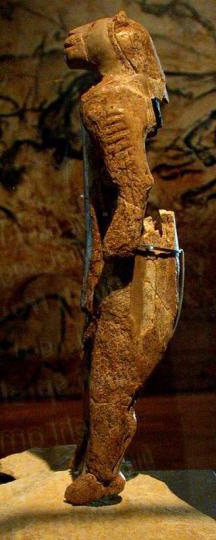“Lion Man”, ‘der Löwenmensch’ in German, is one of the oldest and certainly one of the most remarkable statuettes in human history. It is (calibrated) about 35.000 years old. Because the quality of the art production of neanderthalers never came near of that of Homo sapiens we may suppose that is was made by the first wave of modern people that reached South-Germany.
The statuette was put together from hundreds of pieces. The first 200 parts were found in a cave in Hohlenstein-Stadel, Schwaben1, Germany. It was only in 1969 that researchers realised that this was a statuette that was a combination of a human and an animal, man and lion. Later more pieces were found and the sculpture was completely recomposed. It is 28 cm high and made of mammoth ivory. The height is exceptional for a mobile work of art. It was only when people became sedentary that they would make larger statues. Hunters and gatherers were nomads (there were some exceptions), they could not take many possessions on their trips. A statuette made of stone was seldom larger than 10 cm.
In Schwaben two comparable statuettes were found. One was found in Hohler Fels. Its height was only 2,5 cm.
The explanation reseachers gave for the meaning of this work of art was: a shaman disguised as a lion, a fabulous creature…
For hunters and gatherers hunting, the procurement of meat, was fascinating. Hunters thought animals. They peopled their imagination. We should not be surprised that their paintings in caves mainly show us animals. Many statuettes represent animals but also voluptuous women, the so called Venuses. The Lion Man however is a combination of lion2 and man. Can this be explained?
The combination of a human and an animal is world wide not exceptional. It is observed in Middle America, Latin-America, Mesopotamia, Egypt and India. It cannot be a coincidence that this was the case in different cultures. When Homo sapiens left Africa between 65,000 and 80,000 years ago, he took with him a lot of customs and a common religion, the ancestor cult3. This belief, that exists until today, implied dat living beings had a soul: humans, animals, plants (holy trees), objects, in other words animism. People believed theu had the same soul that could reincarnate from ma, to animal etc., but also in the opposite direction.
The core of this belief still exists today in Hinduism. Originally, people with the same totem were organised in societies of hunters and gatherers that were not identical with their clan or family. They owed each other support, had meetings, initiations holy objects and totem symbols. It is this identification of man with his totem that forms the base of the world wide appearance of statuettes and statues of hybrid creatures, half human and half animal. The historical background of totemism has its origin in Africa more than 80,000 years ago. On that common base developed long after the exodus out of Africa – and this time not connected with eack other – totem statues and totem symbols where man and animal were combined. The Egyptian sphinx had a human head and the body of a lion. Horus had the head of a hawk and a human body. Sobek had the head of a crocodile and the body of a human. These are all examples of combinations from man and beast.
The Löwenmensch is probably a totemic object. Taking in account its small height and the fact that it was found in a cave where it may have been preserved may point in the direction of a holy object of the lion totem. That such a totem existed 35,000 years ago is a distinct possibility. This is confirmed by the finding of two other figurines with a combination human-lion or human-feline. In 2004 a statuette with a height of 2,5 cm was found. In Geißenklösterle another figurine can be interpreted as a combination of a man and a feline.
The Lion Man connects us with the first modern men in Europe 35,000 years ago and later civilisations that are 5,000 years old or younger. It is also an expression of the great esthetic feeling that is typical for Homo sapiens and his great skill.
If you are interested in art you might like these blogs:
Art in Olduvai 1,74 Million Years BP, Baboonhead Rather unknown, undeserved, the oldest known art in the world
The Origin of Aesthetic Feeling and Art Fundamental: How our aesthetic feeling originated in reproduction of man, a darwinian explanation.
7000 BP: The Thinker and the Sitting Woman Two statuettes, one amazinly modern though it maybe 7000 years old
Chauvet Cave, the oldest known cave art in Europe The recently discovered cave shows that the European late palaeolithic culture lasted at least 20,000 years.
The oldest statuettes adapted by man are between 233,000 and 800,000 years old.
The oldest European Venus figurine was found in the Hohle Fels cave (Germany) It is between 35,000 and 40,000 years old.
“Lion Man”, the oldest statuette with a combination man-animal ‘Der Löwenmensch” was found in Germany.
The oldest Love Statuette in the World They keep on loving for ever in the British Museum.
A virtual visit to the Lascaux Cave is mind blowing!
1 Schwaben was to the aurignacian what Firenze (Florence) was for Europe in the art of the 16th and 17th century.
2 At that time there were lions living in Europe.
3 Central belief of the ancestor cult is that all living beings have a soul, their belief is animistic. The word animism is derived form the latin word ‘anima’, soul.
